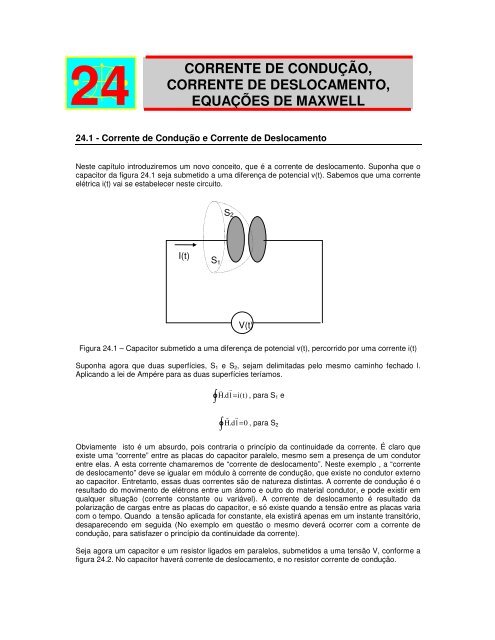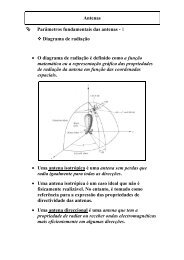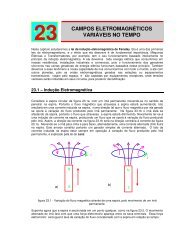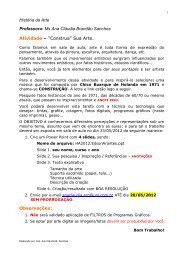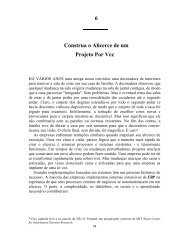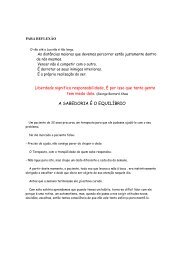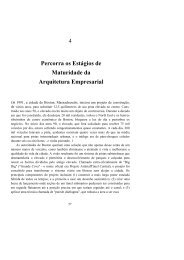jj 24 corrente de condução, corrente de deslocamento, equações
jj 24 corrente de condução, corrente de deslocamento, equações
jj 24 corrente de condução, corrente de deslocamento, equações
You also want an ePaper? Increase the reach of your titles
YUMPU automatically turns print PDFs into web optimized ePapers that Google loves.
<strong>24</strong><br />
CORRENTE DE CONDUÇÃO,<br />
CORRENTE DE DESLOCAMENTO,<br />
EQUAÇÕES DE MAXWELL<br />
<strong>24</strong>.1 - Corrente <strong>de</strong> Condução e Corrente <strong>de</strong> Deslocamento<br />
Neste capítulo introduziremos um novo conceito, que é a <strong>corrente</strong> <strong>de</strong> <strong>de</strong>slocamento. Suponha que o<br />
capacitor da figura <strong>24</strong>.1 seja submetido a uma diferença <strong>de</strong> potencial v(t). Sabemos que uma <strong>corrente</strong><br />
elétrica i(t) vai se estabelecer neste circuito.<br />
I(t)<br />
S1<br />
Figura <strong>24</strong>.1 – Capacitor submetido a uma diferença <strong>de</strong> potencial v(t), percorrido por uma <strong>corrente</strong> i(t)<br />
Suponha agora que duas superfícies, S1 e S2, sejam <strong>de</strong>limitadas pelo mesmo caminho fechado l.<br />
Aplicando a lei <strong>de</strong> Ampére para as duas superfícies teríamos.<br />
∫<br />
H . dl<br />
= i(<br />
t)<br />
, para S1 e<br />
∫<br />
S2<br />
V(t)<br />
H . dl<br />
= 0 , para S2<br />
Obviamente isto é um absurdo, pois contraria o princípio da continuida<strong>de</strong> da <strong>corrente</strong>. É claro que<br />
existe uma “<strong>corrente</strong>” entre as placas do capacitor paralelo, mesmo sem a presença <strong>de</strong> um condutor<br />
entre elas. A esta <strong>corrente</strong> chamaremos <strong>de</strong> “<strong>corrente</strong> <strong>de</strong> <strong>de</strong>slocamento”. Neste exemplo , a “<strong>corrente</strong><br />
<strong>de</strong> <strong>de</strong>slocamento” <strong>de</strong>ve se igualar em módulo à <strong>corrente</strong> <strong>de</strong> <strong>condução</strong>, que existe no condutor externo<br />
ao capacitor. Entretanto, essas duas <strong>corrente</strong>s são <strong>de</strong> natureza distintas. A <strong>corrente</strong> <strong>de</strong> <strong>condução</strong> é o<br />
resultado do movimento <strong>de</strong> elétrons entre um átomo e outro do material condutor, e po<strong>de</strong> existir em<br />
qualquer situação (<strong>corrente</strong> constante ou variável). A <strong>corrente</strong> <strong>de</strong> <strong>de</strong>slocamento é resultado da<br />
polarização <strong>de</strong> cargas entre as placas do capacitor, e só existe quando a tensão entre as placas varia<br />
com o tempo. Quando a tensão aplicada for constante, ela existirá apenas em um instante transitório,<br />
<strong>de</strong>saparecendo em seguida (No exemplo em questão o mesmo <strong>de</strong>verá ocorrer com a <strong>corrente</strong> <strong>de</strong><br />
<strong>condução</strong>, para satisfazer o princípio da continuida<strong>de</strong> da <strong>corrente</strong>).<br />
Seja agora um capacitor e um resistor ligados em paralelos, submetidos a uma tensão V, conforme a<br />
figura <strong>24</strong>.2. No capacitor haverá <strong>corrente</strong> <strong>de</strong> <strong>de</strong>slocamento, e no resistor <strong>corrente</strong> <strong>de</strong> <strong>condução</strong>.
Da teoria <strong>de</strong> circuitos, sabemos que:<br />
e<br />
figura <strong>24</strong>.2 – Resistor e capacitor submetidos a tensão V<br />
V<br />
i R =<br />
R<br />
dV<br />
iC = C<br />
dt<br />
on<strong>de</strong> iR é a <strong>corrente</strong> <strong>de</strong> <strong>condução</strong> no resistor, e iC a <strong>corrente</strong> <strong>de</strong> <strong>de</strong>slocamento no capacitor.<br />
(<strong>24</strong>.1)<br />
(<strong>24</strong>.2)<br />
Vamos agora escrever essas relações baseadas em relações <strong>de</strong> campo, representando os elementos<br />
resistor e capacitor conforme a figura <strong>24</strong>.3.<br />
Figura <strong>24</strong>.3 – representação do capacitor e do resistor, baseada em gran<strong>de</strong>zas <strong>de</strong> campo<br />
A intensida<strong>de</strong> <strong>de</strong> campo elétrico é a mesma, tanto no resistor como no capacitor, e po<strong>de</strong> ser expressa<br />
como:<br />
Para o resistor po<strong>de</strong>mos escrever:<br />
ou:<br />
Para o capacitor po<strong>de</strong>mos escrever:<br />
i<br />
V<br />
i R<br />
V<br />
E=<br />
d<br />
V<br />
= = E × d<br />
R 1<br />
σ<br />
i R<br />
= J<br />
A<br />
¡<br />
J R<br />
iR<br />
V E σ E ε<br />
R<br />
= σE<br />
¡<br />
= σE<br />
d<br />
A<br />
iC<br />
(<strong>24</strong>.3)<br />
(<strong>24</strong>.4)<br />
(<strong>24</strong>.5)<br />
(<strong>24</strong>.6)
ou:<br />
iC = C<br />
dV<br />
dt<br />
A<br />
C= ε<br />
d<br />
(<strong>24</strong>.7)<br />
(<strong>24</strong>.8)<br />
V= Ed<br />
(<strong>24</strong>.9)<br />
A dE<br />
iC = ε d<br />
d dt<br />
iC<br />
dE dD<br />
= J c = ε =<br />
A dt dt<br />
¢<br />
J C<br />
¢<br />
dD<br />
=<br />
dt<br />
(<strong>24</strong>.10)<br />
(<strong>24</strong>.11)<br />
(<strong>24</strong>.12)<br />
£<br />
JC<br />
, a <strong>de</strong>nsida<strong>de</strong> <strong>de</strong> <strong>corrente</strong> no capacitor representa uma <strong>corrente</strong> <strong>de</strong> <strong>de</strong>slocamento, que passará a<br />
£<br />
ser representada por Jd<br />
¤<br />
, e JR<br />
¥<br />
<strong>condução</strong>, que passará a ser representada por J<br />
, a <strong>de</strong>nsida<strong>de</strong> <strong>de</strong> <strong>corrente</strong> no resistor representa uma <strong>corrente</strong> <strong>de</strong><br />
.<br />
Suponha agora um meio com as duas características, ao invés <strong>de</strong> uma resistência pura, em paralelo<br />
com uma capacitância pura (po<strong>de</strong> ser um mau condutor, ou um dielétrico com perdas). A<br />
generalização da lei <strong>de</strong> Ampére para esse meio permite escrever:<br />
¦<br />
=<br />
⎛<br />
⎝<br />
∂D<br />
⎞<br />
dS<br />
∂t<br />
⎠<br />
∫ ∫ ⎟ ¦<br />
¦<br />
¦<br />
¦<br />
H.<br />
dL<br />
⎜<br />
J+<br />
Aplicando o teorema <strong>de</strong> Stokes ao primeiro membro da equação acima, temos:<br />
ou:<br />
§<br />
§<br />
§ ∂D<br />
∇ × H=<br />
J +<br />
∂t<br />
§<br />
§<br />
§ ∂E<br />
∇ × H=<br />
σE+<br />
ε<br />
∂t<br />
(<strong>24</strong>.13)<br />
(<strong>24</strong>.14)<br />
(<strong>24</strong>.15)<br />
O conceito <strong>de</strong> <strong>corrente</strong> <strong>de</strong> <strong>de</strong>slocamento foi introduzido por J. C. Maxwell, para se levar em conta a<br />
possibilida<strong>de</strong> <strong>de</strong> propagação <strong>de</strong> ondas eletromagnéticas no espaço.<br />
Se o campo elétrico varia harmonicamente com o tempo, as <strong>corrente</strong>s <strong>de</strong> <strong>de</strong>slocamento e <strong>condução</strong><br />
estão <strong>de</strong>fasadas <strong>de</strong> 90 graus.<br />
§<br />
§<br />
E = E0<br />
sen ωt<br />
§<br />
§<br />
J = σE0<br />
sen ωt<br />
§<br />
Jd 0<br />
§<br />
= εωE<br />
cosωt<br />
(<strong>24</strong>.15)<br />
(<strong>24</strong>.16)<br />
(<strong>24</strong>.17)
Exemplo <strong>24</strong>.1<br />
Um material com σ = 5,0 S/m e εr = 1,0 é submetido a uma intensida<strong>de</strong> <strong>de</strong> campo elétrico <strong>de</strong><br />
250sen10 10 t V/m. Calcular as <strong>de</strong>nsida<strong>de</strong>s <strong>de</strong> <strong>corrente</strong> <strong>de</strong> <strong>condução</strong> e <strong>de</strong> <strong>de</strong>slocamento. Em que<br />
frequência elas terão a mesma amplitu<strong>de</strong> máxima ?<br />
Solução<br />
J<br />
¨<br />
E<br />
cond<br />
Figura <strong>24</strong>.4 – dielétrico com perdas<br />
= = σE<br />
= 5 × 250 sen10<br />
10<br />
t<br />
Jcond<br />
1250sen10<br />
=<br />
J<br />
<strong>de</strong>sl<br />
10<br />
t<br />
( A / m<br />
dE<br />
= ε = 8.<br />
85 × 10<br />
dt<br />
J<strong>de</strong>sl<br />
= 22.<br />
1cos10<br />
10<br />
t<br />
−12<br />
( A / m<br />
2<br />
)<br />
× 10<br />
Para a mesma amplitu<strong>de</strong> máxima:<br />
σ = εω<br />
2<br />
)<br />
10<br />
× 250 cos10<br />
σ 5. 0<br />
11<br />
ω = =<br />
= 5.<br />
65 × 10 rad / s<br />
−12<br />
ε 8.<br />
85 × 10<br />
w<br />
f = =<br />
2π<br />
Exemplo <strong>24</strong>.2<br />
Um capacitor co-axial com raio interno igual a 5 mm, raio externo 6 mm, comprimento <strong>de</strong> 500 mm<br />
tem um dielétrico com εr = 6,7. Se uma tensão <strong>de</strong> 250sen377t é aplicada, <strong>de</strong>termine a <strong>corrente</strong> <strong>de</strong><br />
<strong>de</strong>slocamento e compare-a com a <strong>corrente</strong> <strong>de</strong> <strong>condução</strong>.<br />
Solução<br />
Id(t)<br />
Jcond J<strong>de</strong>sl<br />
Figura <strong>24</strong>.5 – Capacitor co-axial<br />
Neste exemplo, a <strong>corrente</strong> entre as placas do<br />
capacitor será do tipo <strong>corrente</strong> <strong>de</strong><br />
<strong>de</strong>slocamento, e a <strong>corrente</strong> no condutor<br />
externo <strong>corrente</strong> <strong>de</strong> <strong>condução</strong>. Subenten<strong>de</strong>-se<br />
que o dielétrico é sem perdas.<br />
Da Teoria <strong>de</strong> circuitos:<br />
dV<br />
ic = C<br />
dt<br />
V(t)<br />
ic(t)<br />
i<br />
c<br />
89.<br />
5<br />
GHz<br />
2πεrε<br />
0l<br />
−<br />
C = = 1.<br />
02 × 10<br />
ln<br />
=<br />
( r r )<br />
0<br />
1.<br />
02 × 10<br />
i<br />
c<br />
1<br />
−9<br />
× 377 ×<br />
−5<br />
= 9.<br />
63×<br />
10<br />
Da teoria eletromagnética:<br />
9<br />
F<br />
250cos<br />
377t<br />
cos377t<br />
O potencial entre as placas do capacitor<br />
obe<strong>de</strong>ce à equação <strong>de</strong> Laplace:<br />
2<br />
∇ V = 0<br />
Em coor<strong>de</strong>nadas cilíndricas, ela se reduz a:<br />
1 ∂ ⎛ dV ⎞<br />
⎜r<br />
⎟ = 0<br />
r ∂r<br />
⎝ dr ⎠<br />
Integrando uma vez em relação a r:<br />
dV<br />
r =<br />
dr<br />
A<br />
A<br />
10<br />
t
Integrando pela segunda vez em relaçao a r:<br />
V = A × ln( r)<br />
+ B<br />
Utilizando as condições <strong>de</strong> contorno:<br />
e<br />
Resulta:<br />
0 = A × ln 0.<br />
005 + B<br />
250 sen 377t<br />
= A × ln 0.<br />
006 + B<br />
250sen<br />
377t<br />
A =<br />
ln( 0.<br />
006 / 0.<br />
005)<br />
250sen<br />
377t<br />
B =<br />
ln( 0.<br />
005)<br />
ln( 0.<br />
006 / 0.<br />
005)<br />
250sen<br />
377t<br />
V =<br />
ln r +<br />
ln( 0.<br />
006 / 0.<br />
005)<br />
250sen<br />
377t<br />
ln( 0.<br />
005)<br />
ln( 0.<br />
006 / 0.<br />
005)<br />
<strong>24</strong>.2 – Relações Gerais <strong>de</strong> Campo<br />
©<br />
E = − ∇V<br />
© 250sen<br />
377t<br />
1<br />
E = −<br />
â r<br />
ln( 0.<br />
006 / 0.<br />
005)<br />
r<br />
©<br />
J<br />
d<br />
©<br />
Jd ©<br />
dE<br />
= ε<br />
dt<br />
−6<br />
30.<br />
6 × 10<br />
= −<br />
r<br />
i<br />
d<br />
id = Jd<br />
× S<br />
cos 377tâ<br />
−5<br />
= − 9.<br />
63 × 10<br />
o que comprova que a <strong>corrente</strong> <strong>de</strong><br />
<strong>de</strong>slocamento, <strong>de</strong>ntro do capacitor, é igual à<br />
<strong>corrente</strong> <strong>de</strong> <strong>condução</strong>, no condutor externo. O<br />
sinal menos obtido não afeta a nossa<br />
resposta, pois é fruto <strong>de</strong> arbitrarieda<strong>de</strong>s ao se<br />
impor direções e condições <strong>de</strong> contorno.<br />
Em ocasião anterior foi mostrado que a divergência do campo magnético é nula, ou seja :<br />
∇ •<br />
<br />
B = 0<br />
<br />
E do calculo vetorial, sabe-se que a seguinte relação é válida, para qualquer função vetorial F :<br />
∇ •<br />
<br />
<br />
( ∇ × F ) = 0<br />
<br />
Ficando <strong>de</strong>monstrada a existência <strong>de</strong> um vetor potencial magnético A , tal que :<br />
<br />
B = ∇ ×<br />
Por outro lado, a lei da Faraday expressa na forma pontual é :<br />
∇ ×<br />
<br />
E<br />
= −<br />
Substituindo (<strong>24</strong>.20 ) em ( <strong>24</strong>.21), teremos, portanto :<br />
Ou :<br />
∇ ×<br />
<br />
E<br />
= −<br />
∂<br />
<br />
A<br />
<br />
∂B<br />
∂t<br />
<br />
( ∇ × A)<br />
∂t<br />
A<br />
r<br />
(<strong>24</strong>.18)<br />
(<strong>24</strong>.19)<br />
(<strong>24</strong>.20)<br />
(<strong>24</strong>.21)<br />
(<strong>24</strong>.22)
⎛ ∂A<br />
⎞<br />
∇ × ⎜E<br />
⎟<br />
⎜<br />
+ = 0<br />
t ⎟<br />
⎝ ∂ ⎠<br />
Des<strong>de</strong> que o rotacional da expressão entre parêntesis é igual a zero, ela <strong>de</strong>ve ser igual ao gradiente<br />
<strong>de</strong> uma função escalar. Assim, po<strong>de</strong>mos escrever :<br />
<br />
∂A<br />
E + = ∇f<br />
∂t<br />
(<strong>24</strong>.23)<br />
(<strong>24</strong>.<strong>24</strong>)<br />
On<strong>de</strong> f é uma função escalar. Fazendo f = −V<br />
, o vetor intensida<strong>de</strong> po<strong>de</strong> ser escrito <strong>de</strong> uma forma<br />
generalizada, servindo tanto para campos elétricos variantes no tempo, como para campos elétricos<br />
estáticos :<br />
<br />
<br />
∂A<br />
E = − ∇V<br />
−<br />
∂t<br />
(<strong>24</strong>.25)<br />
Relembrando, as expressões clássicas para o potencial escalar eletrostático, e para o vetor potencial<br />
magnético são, respectivamente :<br />
∫ ρ 1<br />
V = dv<br />
(<strong>24</strong>.26)<br />
4πε<br />
v<br />
0 R<br />
Em termos da Equação <strong>de</strong> Poisson, temos :<br />
Para campos elétricos e :<br />
Para campos magnéticos lineares<br />
∇<br />
2<br />
<br />
A =<br />
A<br />
µ<br />
4π<br />
∫<br />
v<br />
<br />
J<br />
dv<br />
R<br />
∇ V = −<br />
ρ<br />
ε<br />
2<br />
⎛<br />
= µ ⎜−<br />
J<br />
⎝<br />
<strong>24</strong>.3 - As Equações <strong>de</strong> Maxwell para Campos Variáveis no Tempo.<br />
− σ<br />
∂A<br />
∂t<br />
⎞<br />
⎟<br />
⎠<br />
(<strong>24</strong>.27)<br />
(<strong>24</strong>.28)<br />
(<strong>24</strong>.29)<br />
No capítulo 15 estabelecemos as 4 <strong>equações</strong> <strong>de</strong> Maxwell para campos elétricos e magnéticos<br />
estáticos (invariantes no tempo). Elas po<strong>de</strong>m ser escrito tanto na forma integral:<br />
<br />
<br />
<br />
∫ H.<br />
dL=<br />
∫<br />
∫<br />
s<br />
l s<br />
<br />
JdS<br />
<br />
<br />
E.<br />
dL=0<br />
∫<br />
∫<br />
<br />
<br />
D.<br />
dS=<br />
ρdV<br />
v<br />
<br />
<br />
∫ B.<br />
dS=<br />
0<br />
s<br />
(<strong>24</strong>.30)<br />
(<strong>24</strong>.31)<br />
(<strong>24</strong>.32)<br />
(<strong>24</strong>.33)
Ou na forma diferencial :<br />
<br />
<br />
∇ × H=<br />
J<br />
<br />
∇×<br />
E= 0<br />
<br />
∇. D=<br />
ρ<br />
<br />
∇.<br />
B=<br />
0<br />
(<strong>24</strong>.34)<br />
(<strong>24</strong>.35)<br />
(<strong>24</strong>.36)<br />
(<strong>24</strong>.37)<br />
As 4 <strong>equações</strong> <strong>de</strong> Maxwell po<strong>de</strong>m também ser escritas, consi<strong>de</strong>rando-se campos elétricos e<br />
magnéticos variáveis no tempo. Na forma diferencial temos:<br />
E na forma diferencial :<br />
<br />
=<br />
⎛<br />
⎝<br />
∂D<br />
⎞<br />
dS<br />
∂t<br />
⎠<br />
∫ ∫ ⎟ <br />
<br />
<br />
<br />
H.<br />
dL<br />
⎜<br />
J +<br />
∂B<br />
= dS<br />
t<br />
<br />
<br />
<br />
∫ E.<br />
dL<br />
− ∫ ∂<br />
∫<br />
s<br />
∫<br />
<br />
<br />
D.<br />
dS=<br />
ρdV<br />
v<br />
<br />
<br />
∫ B.<br />
dS=<br />
0<br />
s<br />
<br />
<br />
∂D<br />
∇ × H=<br />
J+<br />
∂t<br />
∂B<br />
∇ × E=<br />
−<br />
∂t<br />
<br />
∇. D=<br />
ρ<br />
<br />
∇.<br />
B=<br />
0<br />
(<strong>24</strong>.38)<br />
(<strong>24</strong>.39)<br />
(<strong>24</strong>.40)<br />
(<strong>24</strong>.41)<br />
(<strong>24</strong>.42)<br />
(<strong>24</strong>.43)<br />
(<strong>24</strong>.44)<br />
(<strong>24</strong>.45)<br />
Observe que a 3ª e 4ª equação não mudam em relação aos campos estáticos. A segunda equação<br />
correspon<strong>de</strong> à lei <strong>de</strong> Faraday, consi<strong>de</strong>rando efeito variacional da tensão induzida.<br />
<strong>24</strong>.2-1 - Equações <strong>de</strong> Maxwell no Espaço Livre<br />
Quando Maxwell formulou as suas <strong>equações</strong>, a sua maior preocupação era <strong>de</strong>monstrar a existência<br />
<strong>de</strong> ondas eletromagnéticas se propagando no espaço livre. Neste caso, não existirá <strong>corrente</strong> <strong>de</strong><br />
<strong>condução</strong>, nem <strong>de</strong>nsida<strong>de</strong>s <strong>de</strong> cargas livres. Assim as <strong>equações</strong> po<strong>de</strong>m ser simplificadas:<br />
∂D<br />
= dS<br />
t<br />
<br />
<br />
<br />
∫ H.<br />
dL<br />
∫ ∂<br />
(<strong>24</strong>.46)
E na forma diferencial:<br />
ou:<br />
∂B<br />
= dS<br />
t<br />
<br />
<br />
<br />
∫ E.<br />
dL<br />
− ∫ ∂<br />
∫<br />
s<br />
<br />
<br />
D.<br />
dS=<br />
0<br />
<br />
<br />
∫ B.<br />
dS=<br />
0<br />
s<br />
<br />
∂D<br />
∇×<br />
H= ∂t<br />
∂B<br />
∇ × E=<br />
−<br />
∂t<br />
<br />
∇.<br />
D=<br />
0<br />
<br />
∇.<br />
B=<br />
0<br />
<br />
∂E<br />
∇ × H= ε0<br />
∂t<br />
<br />
∂H<br />
∇ × E= − µ 0<br />
∂t<br />
<br />
∇.<br />
E=<br />
0<br />
<br />
∇.<br />
H=<br />
0<br />
<strong>24</strong>.2.-2 Equações <strong>de</strong> Maxwell para Campos Variantes Harmonicamente com o Tempo<br />
(<strong>24</strong>.47)<br />
(<strong>24</strong>.48)<br />
(<strong>24</strong>.49)<br />
(<strong>24</strong>.50)<br />
(<strong>24</strong>.51)<br />
(<strong>24</strong>.52)<br />
(<strong>24</strong>.53)<br />
(<strong>24</strong>.54)<br />
(<strong>24</strong>.55)<br />
(<strong>24</strong>.56)<br />
(<strong>24</strong>.57)<br />
Finalmente apresentamos as formulações das <strong>equações</strong> <strong>de</strong> Maxwell para campos eletromagnéticos<br />
que variam harmonicamente com o tempo (não necessariamente o espaço livre). Consi<strong>de</strong>rando uma<br />
variação do tipo e jwt , elas po<strong>de</strong>m ser escritas como:<br />
E na forma diferencial<br />
<br />
<br />
∫ H.<br />
dL=<br />
( σ+<br />
jωε)<br />
∫<br />
s s<br />
<br />
<br />
∫ E.<br />
dL=<br />
− jωµ<br />
∫<br />
l s<br />
∫<br />
∫<br />
<br />
<br />
EdS<br />
<br />
<br />
HdS<br />
<br />
<br />
D.<br />
dS=<br />
ρdV<br />
v<br />
s<br />
<br />
<br />
∫ B.<br />
dS=<br />
0<br />
s<br />
<br />
<br />
∇<br />
× H=<br />
( σ+<br />
jωε)E<br />
(<strong>24</strong>.59)<br />
(<strong>24</strong>.60)<br />
(<strong>24</strong>.61)<br />
(<strong>24</strong>.62)
∇ × E=<br />
− jωµ<br />
H<br />
<br />
∇.<br />
D=<br />
0<br />
<br />
∇.<br />
B=<br />
0<br />
Deste último grupo <strong>de</strong> <strong>equações</strong> partiremos para formular a equação <strong>de</strong> onda eletromagnética.<br />
EXERCÍCIOS<br />
(<strong>24</strong>.63)<br />
(<strong>24</strong>.64)<br />
(<strong>24</strong>.65)<br />
(<strong>24</strong>.66)<br />
1)- Conhecida a <strong>de</strong>nsida<strong>de</strong> <strong>de</strong> <strong>corrente</strong> <strong>de</strong> <strong>condução</strong> num dielétrico dissipativo,Jc 0,02 sen i0 9 t(A/m 2 ),<br />
encontre a <strong>de</strong>nsida<strong>de</strong> <strong>de</strong> <strong>corrente</strong> <strong>de</strong> <strong>de</strong>slocamento se σ 10 3 Sim e ε = 6,5.<br />
1,15x10 -6 cos10 -9 t (A/m 2 )<br />
2)- Um condutor <strong>de</strong> seção reta circular <strong>de</strong> 1,5 mm <strong>de</strong> raio suporta uma <strong>corrente</strong> ic = 5,5 sen4x10 10 t<br />
(µA). Quanto vale a amplitu<strong>de</strong> da <strong>de</strong>nsida<strong>de</strong> <strong>de</strong> <strong>corrente</strong> <strong>de</strong> <strong>de</strong>slocamento, se σ = 35 MS/m εr = 1<br />
7,87x10 -3 µA/m 2<br />
3)- Descubra a freqüência para a qual as <strong>de</strong>nsida<strong>de</strong>s <strong>de</strong> <strong>corrente</strong> <strong>de</strong> <strong>condução</strong> e <strong>de</strong>slocamento são<br />
idênticas em (a) água <strong>de</strong>stilada, on<strong>de</strong> σ = 2,0×10 -4 S/m, εr = 81; (b) água salgada, on<strong>de</strong> σ= 4,0<br />
S/m e εr = 1.<br />
(a) 4,44 x 104 Hz;(b) 7,19 x 1010 Hz<br />
4)- Duas cascas esféricas condutoras concêntricas com raios r1 = 0,5 mm e r2 = 1 mm, acham-se<br />
separadas por um dielétrico <strong>de</strong> εr = 8,5. Encontre a capacitância e calcule ic dada uma tensão<br />
aplicada v = 150sen5000t(V). Calcule a <strong>corrente</strong> <strong>de</strong> <strong>de</strong>slocamento iD e compare-a com ic.<br />
ic = iD = 7,09×10-7cos5000t (A)<br />
5)- Duas placas condutoras planas e paralelas <strong>de</strong> área 0,05 m 2 acham-se separadas por 2 mm <strong>de</strong> um<br />
dielétrico com perdas com εr= 8,3 e σ = 8,0×10 -4 S/m. Aplicada uma tensão v = 10 sen 10 7 t (V),<br />
calcule o valor rms da <strong>corrente</strong> total.<br />
0,192 A<br />
6)- Um capacitor <strong>de</strong> placas paralelas, separadas por 0,6 mm e com um dielétrico <strong>de</strong> εr = 15,3 tem uma<br />
tensão aplicada <strong>de</strong> rms 25 V na frequência <strong>de</strong> 15 GHz. Calcule o rms da <strong>de</strong>nsida<strong>de</strong> <strong>de</strong> <strong>corrente</strong> <strong>de</strong><br />
<strong>de</strong>slocamento. Despreze o espraiamento.<br />
5,32×105 A/m2


